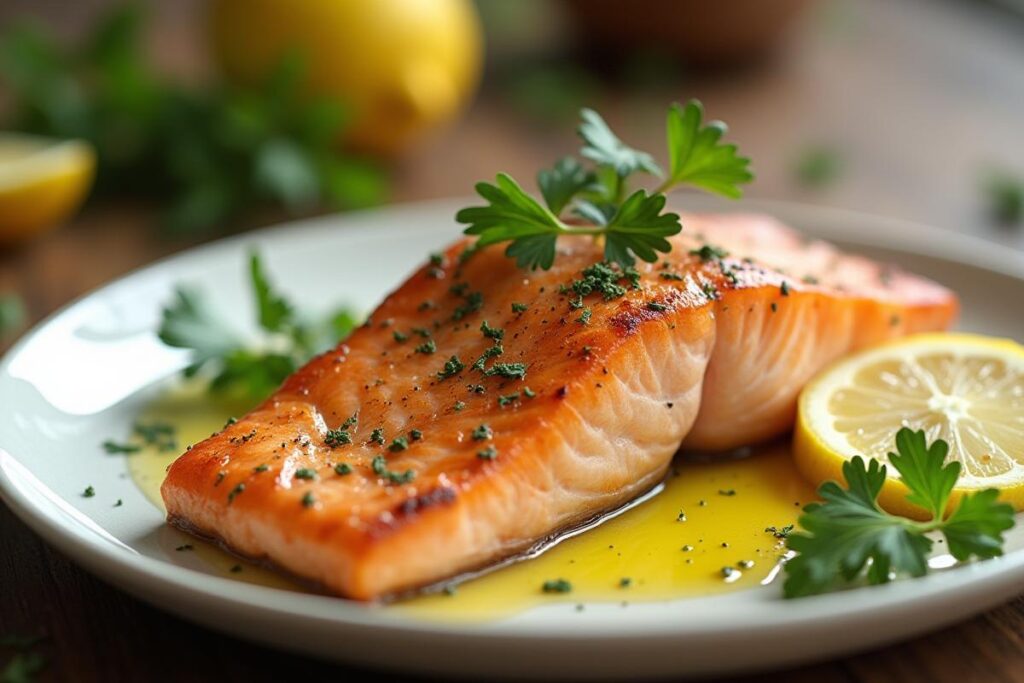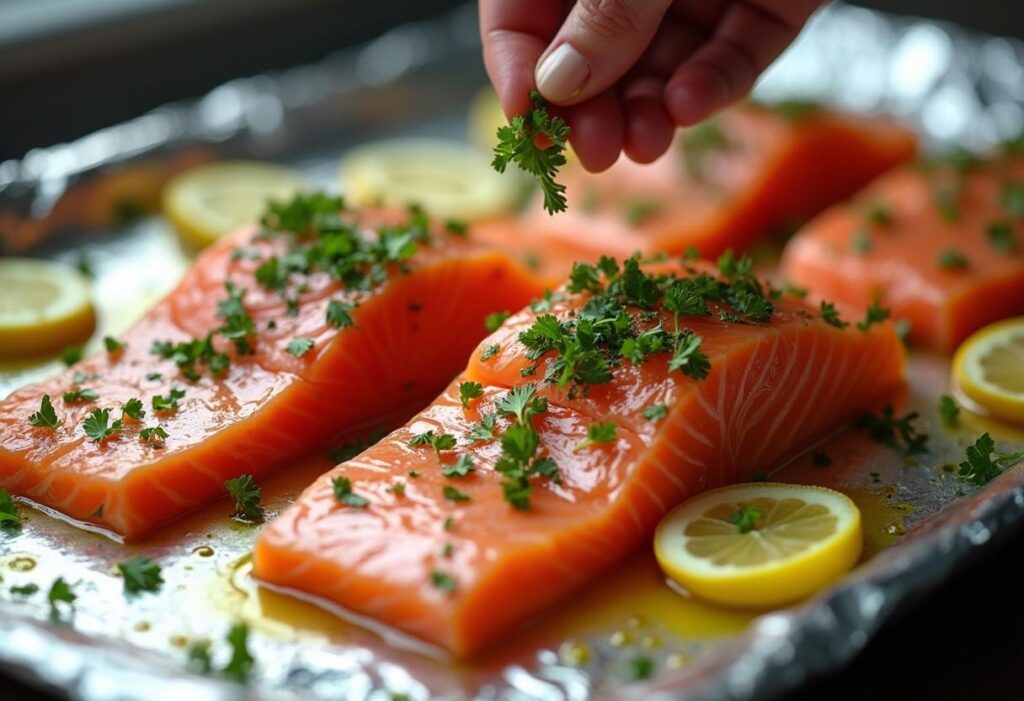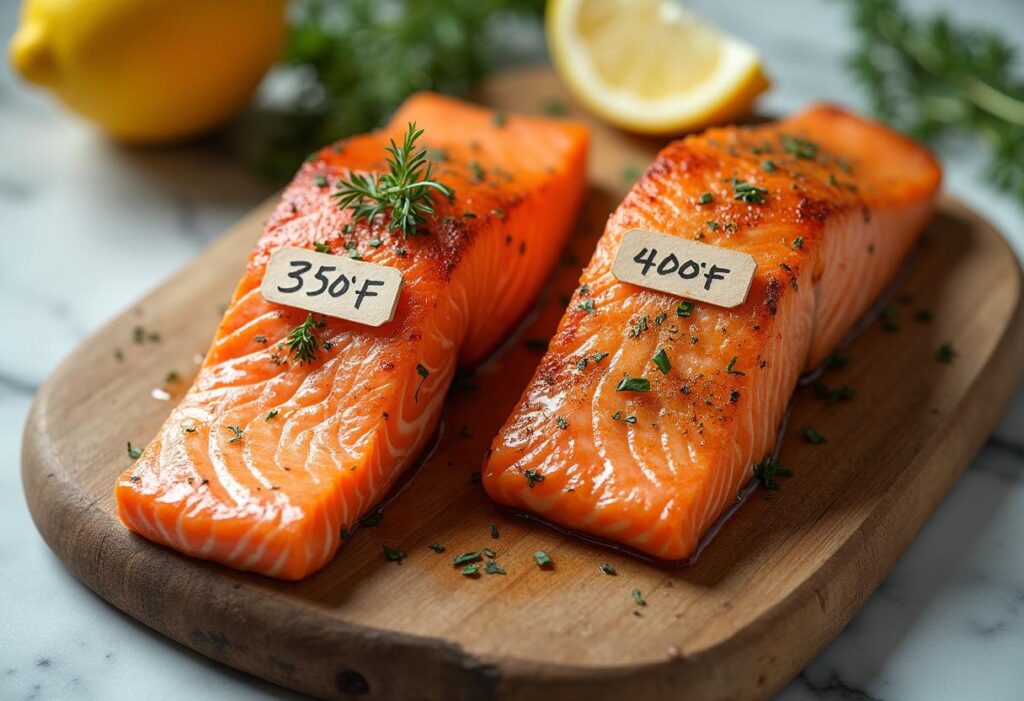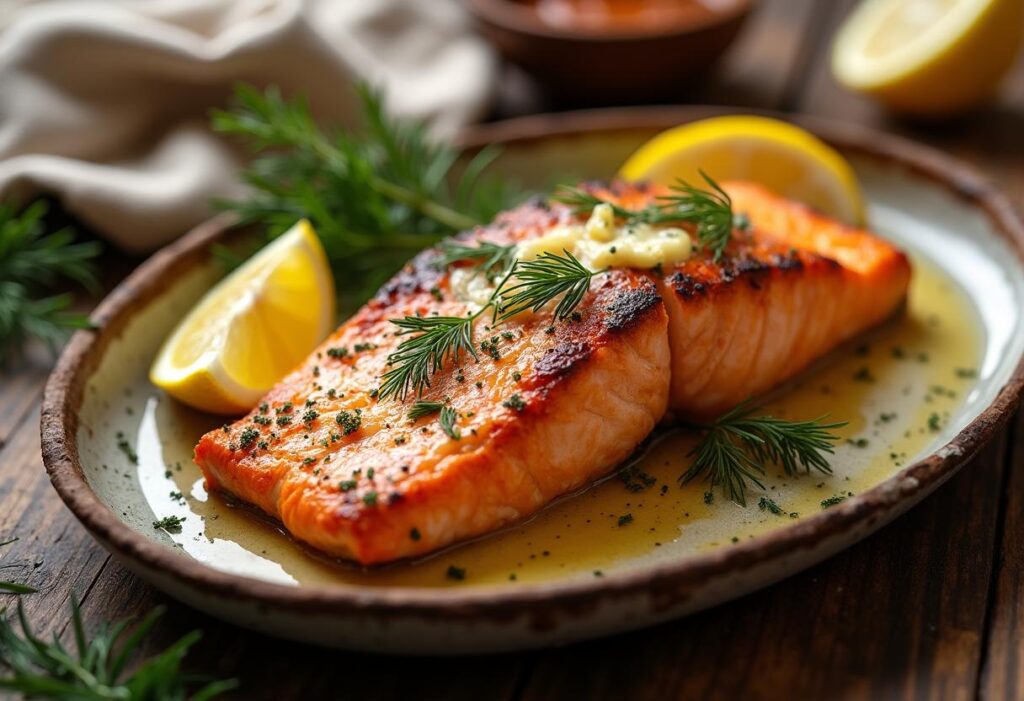
Salmon is one of the healthiest and tastiest fish you can enjoy, and baking it is an easy way to bring out its best flavors. Whether you’re a seafood lover or new to cooking fish, this guide will help you master the art of preparing perfectly baked salmon. We’ll explore the best ingredients, techniques, and tips to make this dish a success every single time. From choosing the right baking temperature to pairing it with delicious side dishes, we’ve got you covered. Let’s dive into the ultimate baked salmon recipe and make it your new go-to meal!
Why You’ll Love This Baked Salmon Recipe
Benefits of Baking Salmon at Home
Baking salmon is one of the easiest and healthiest ways to prepare a flavorful meal. Unlike frying or grilling, baking helps retain the fish’s natural moisture and nutrients. Plus, it requires minimal equipment and effort—no standing over a hot stove or constantly flipping fillets!
Not only is baked salmon versatile, but it’s also highly customizable. With just a few basic ingredients, you can create endless variations. Whether you prefer a zesty lemon butter sauce or a rich honey glaze, baking ensures your salmon absorbs every bit of flavor.
Another big win? Baking salmon is foolproof! Even beginner cooks can whip up a restaurant-quality dish by following simple steps. Once you’ve tried it, you’ll wonder why you didn’t bake salmon sooner.
Quick and Easy Preparation for Any Skill Level
One of the best things about baking salmon is how quick it is to prepare. With just five minutes of prep and around 15 minutes in the oven, you can have a healthy, satisfying meal ready to serve.
No special skills are required—just season, pop it into the oven, and let it bake. It’s perfect for busy weeknights, family dinners, or impressing guests at a gathering. Plus, cleanup is a breeze if you line your baking tray with foil or parchment paper.
Ingredients for the Best Baked Salmon Recipe
Essential Ingredients for Flawless Flavor
When it comes to baked salmon, the right ingredients can make all the difference. Here’s a breakdown of the must-haves for creating the perfect dish:
| Ingredient | Quantity | Purpose |
|---|---|---|
| Fresh Salmon Fillets | 4 fillets (6 oz each) | The star of the dish, providing rich flavor and nutrients. |
| Olive Oil | 2 tbsp | Adds moisture and helps the seasonings stick. |
| Lemon Juice | 2 tbsp | Enhances flavor with a zesty brightness. |
| Garlic (minced) | 3 cloves | Adds a punch of savory depth to the seasoning. |
| Salt | 1 tsp | Essential for bringing out the salmon’s natural flavors. |
| Black Pepper | ½ tsp | Adds a subtle, spicy kick. |
Optional Ingredients to Customize Your Dish
Elevate your baked salmon with these optional additions:
| Ingredient | Quantity | Purpose |
|---|---|---|
| Honey or Maple Syrup | 1 tbsp | Adds a touch of sweetness to balance the flavors. |
| Fresh Herbs (e.g., Dill, Parsley) | 2 tbsp (chopped) | Adds a fresh, aromatic finish. |
| Paprika | ½ tsp | Introduces a smoky, slightly spicy flavor. |
| Red Pepper Flakes | ¼ tsp | For a bit of heat, if you like spice. |
| Butter (melted) | 2 tbsp | Adds richness and creates a silky glaze. |
These ingredients can be adjusted based on your preferences, making it easy to customize the dish to suit your taste. Combine the essentials with your favorite optional ingredients, and you’re all set for a delicious baked salmon experience!
Step-by-Step Guide to Baking Salmon

Mastering the art of baking salmon is easier than you think. Follow these simple steps to ensure perfectly cooked, moist, and flavorful salmon every time.
How to Prep Your Salmon (Room Temperature Tips)
- Bring Salmon to Room Temperature
Remove the salmon from the fridge 15-20 minutes before baking. This step ensures even cooking and prevents the fish from becoming rubbery. - Check for Bones
Use a pair of tweezers to remove any pin bones from the fillets. Gently run your fingers along the flesh to find any hidden bones. - Pat Dry for Better Texture
Use a paper towel to pat the salmon fillets dry. This helps the seasonings stick and ensures a slightly crispy exterior. - Season Generously
Brush the salmon with olive oil, sprinkle with salt, pepper, and your chosen spices, and drizzle with lemon juice for extra flavor.
Ideal Baking Temperatures: 350°F vs. 400°F
- 350°F: Baking at this temperature results in tender, moist salmon. It’s perfect for thicker cuts and ensures the fish stays juicy.
- Cooking Time: 20-25 minutes for 1-inch thick fillets.
- 400°F: This temperature creates a slightly crispy top while keeping the interior flaky. It’s ideal if you want a golden-brown finish.
- Cooking Time: 12-15 minutes for 1-inch thick fillets.
- Tip: Always check the internal temperature of the salmon using a food thermometer. It should reach 145°F for safe consumption.

Should You Use Foil or Parchment Paper?
- Foil Method
- Benefits: Locks in moisture and flavors, making it nearly impossible to overcook the salmon.
- How to Use: Place the salmon on foil, add seasonings, and wrap it into a packet before baking.
- Parchment Paper Method
- Benefits: Provides a non-stick surface and allows air circulation, resulting in a light and flaky texture.
- How to Use: Lay the fillets on parchment, fold it into a pouch, and bake.
Pro Tip: If you want a slightly crispy top, bake uncovered for the last few minutes, regardless of the method.
Common Mistakes to Avoid When Baking Salmon
Even though baking salmon is straightforward, a few common mistakes can impact the final result. Here’s how to avoid them and ensure your salmon is always cooked to perfection.
Overcooking and How to Prevent It
- Overcooking the Salmon
- The most frequent mistake is leaving the salmon in the oven for too long, which dries it out and makes it tough.
- Solution: Use a food thermometer to check for doneness. The ideal internal temperature is 145°F. Remove the salmon from the oven as soon as it reaches this temperature and let it rest for a few minutes.
- Setting the Wrong Oven Temperature
- Baking at temperatures that are too high can cause the edges to burn before the center cooks through.
- Solution: Stick to the recommended temperatures: 350°F for tender salmon or 400°F for a crispy top.
Using Fresh vs. Frozen Salmon
- Starting with Frozen Salmon
- Baking salmon directly from frozen can lead to uneven cooking, with the outer layers overcooked and the center still raw.
- Solution: Always thaw frozen salmon in the refrigerator overnight or use the cold water method to thaw it more quickly.
- Not Using Fresh Salmon
- Stale or low-quality salmon often has a fishy odor and dull flesh, resulting in an unappealing dish.
- Solution: Choose fresh salmon with a bright pink or reddish-orange color and no strong odor.
Skipping the Resting Period
- Cutting Too Soon
- Slicing the salmon immediately after baking causes the juices to escape, leaving the fillet dry.
- Solution: Let the salmon rest for about 3-5 minutes after removing it from the oven to lock in the moisture.
- Not Accounting for Carryover Cooking
- Even after you remove the salmon from the oven, residual heat will continue to cook it slightly.
- Solution: Take the salmon out a couple of degrees before it hits 145°F for perfectly cooked results.
Tips for Getting the Perfectly Moist Baked Salmon

Achieving perfectly moist baked salmon doesn’t require fancy techniques. A few tried-and-true tips can elevate your dish from ordinary to extraordinary.
Tricks to Lock in Flavor and Juiciness
- Use a Marinade or Rub
- Marinate your salmon for at least 15-20 minutes before baking to infuse it with flavor and moisture. A blend of olive oil, lemon juice, garlic, and herbs works wonders.
- Pro Tip: Avoid over-marinating as the acidity can break down the texture of the fish.
- Don’t Skip the Oil or Butter
- A light coating of olive oil or melted butter helps seal in moisture and creates a barrier against drying out.
- Tip: Brush the salmon with your choice of fat before adding seasonings.
- Bake in a Covered Packet
- Using foil or parchment paper to create a packet traps steam, ensuring the salmon cooks evenly and stays moist.
- Tip: For a crispy top, uncover the packet during the last 2-3 minutes of baking.
Adding a Crispy Top for Extra Texture
- Sprinkle Breadcrumbs or Parmesan
- To add a delightful crunch, top your salmon with a mixture of breadcrumbs and Parmesan cheese.
- Pro Tip: Lightly spray the topping with oil before baking to achieve a golden crust.
- Broil for the Last Few Minutes
- After baking, switch your oven to the broil setting for 1-2 minutes. Keep a close eye to prevent burning.
- Pro Tip: Add a drizzle of honey or maple syrup for a caramelized finish.
Delicious Side Dishes to Pair with Baked Salmon
Baked salmon is versatile and pairs wonderfully with a variety of side dishes. From fresh vegetables to hearty grains, here are some delicious options to elevate your meal.
Fresh Salads and Roasted Vegetables
- Crisp Green Salad
- A simple green salad with arugula, spinach, and a light vinaigrette perfectly complements the richness of baked salmon. Add cherry tomatoes, cucumbers, and avocado for extra flavor.
- Roasted Asparagus or Broccoli
- Roasting vegetables like asparagus or broccoli with olive oil, garlic, and a sprinkle of Parmesan is a quick and healthy option.
- Tip: Bake the vegetables alongside the salmon to save time and enhance the flavors.
- Mediterranean Chickpea Salad
- A blend of chickpeas, red onions, cucumbers, and feta cheese, tossed with lemon juice and olive oil, offers a refreshing and tangy side dish.
Rice, Quinoa, and Other Starch Options
- Garlic Herb Rice
- Fluffy white or brown rice seasoned with garlic, parsley, and butter adds a comforting element to your salmon dinner.
- Tip: Add a squeeze of lemon juice to the rice for a zesty touch.
- Quinoa with Roasted Vegetables
- Packed with protein, quinoa is a great choice for a healthier side. Mix it with roasted peppers, zucchini, or butternut squash for a vibrant dish.
- Lemon Butter Pasta
- A light pasta tossed with lemon butter sauce pairs beautifully with baked salmon for a restaurant-quality meal.
FAQs About Baking Salmon
When it comes to baking salmon, many questions arise about techniques, temperatures, and tips. Let’s address the most common ones to help you become a pro.
Is It Better to Bake Salmon at 350°F or 400°F?
Both temperatures work well depending on your preferences:
- 350°F: Best for achieving a tender and moist texture. It’s ideal for thicker cuts that require gentle, even cooking.
- 400°F: Great for a slightly crispy top without compromising on moisture. It’s perfect for thinner cuts or when you want a golden-brown finish.
- Pro Tip: No matter the temperature, always check for an internal temperature of 145°F to ensure your salmon is perfectly cooked.
How Long Should You Cook Salmon at 400°F?
Cooking time depends on the thickness of the salmon fillet:
- For a 1-inch thick fillet, bake for 12-15 minutes.
- For thicker fillets, extend the time by 3-5 minutes.
- Use a food thermometer to confirm doneness, as overcooking can lead to dry salmon.
Should Salmon Be Covered or Uncovered When Baking?
Covering salmon while baking traps steam, ensuring a moist result.
- Covered: Ideal for locking in moisture, especially if baking at higher temperatures. Use foil or parchment paper to create a packet.
- Uncovered: Best for achieving a crispy texture on top. Uncover for the last 2-3 minutes of baking to get a lightly browned finish.
Is It Better to Use Foil or Parchment Paper?
Both options have unique benefits:
- Foil: Retains moisture and flavors, creating a steam-like effect. Perfect for seasoning-heavy recipes.
- Parchment Paper: Provides a non-stick surface and a lighter, flakier texture. It’s a healthier alternative since it doesn’t involve direct contact with aluminum.
What Is the Tastiest Way to Cook Salmon?
While baking is one of the easiest methods, combining it with flavorful seasonings ensures a tasty result. Some popular options include:
- Lemon Garlic Butter: A classic combination that enhances the natural richness of salmon.
- Honey Glaze: Adds a sweet, caramelized crust.
- Herb-Crusted: Incorporating fresh dill, parsley, or basil adds depth and aroma.
Should Salmon Be Room Temperature Before Baking?
Yes! Allowing salmon to rest at room temperature for 15-20 minutes ensures even cooking. Baking cold salmon straight from the fridge can cause uneven results, with the outside overcooking before the center is done.
Creative Variations of Baked Salmon
Baking salmon doesn’t have to be repetitive. Experimenting with different flavors and ingredients can transform your dish into something truly unique. Here are some creative variations:
Lemon Garlic Butter Baked Salmon
This classic recipe is perfect for citrus lovers:
- Ingredients: Combine melted butter, fresh lemon juice, minced garlic, and parsley.
- Method: Brush the mixture over the salmon before baking, and add lemon slices on top.
- Why You’ll Love It: The buttery, zesty flavor perfectly complements the salmon’s richness.
Honey Glazed Baked Salmon
For a sweet and savory twist:
- Ingredients: Mix honey, soy sauce, garlic, and a splash of apple cider vinegar.
- Method: Glaze the salmon fillets and bake until caramelized. Broil for the last 2 minutes for a crispy finish.
- Why You’ll Love It: The honey creates a delicious caramelized crust that enhances the salmon’s natural sweetness.
Herb-Crusted Baked Salmon
This variation is ideal for herb lovers:
- Ingredients: Blend breadcrumbs, Parmesan cheese, fresh dill, and thyme.
- Method: Spread a thin layer of Dijon mustard over the fillets, then press the herb mixture on top before baking.
- Why You’ll Love It: The herby crust adds a delightful crunch and fragrant flavor to each bite.
How to Store and Reheat Baked Salmon
Leftover baked salmon can be just as delicious if stored and reheated correctly. Here’s how to do it:
Best Practices for Storing Leftovers
- Cool Completely Before Storing
- Let the salmon cool to room temperature before placing it in the fridge.
- Use Airtight Containers
- Store the salmon in an airtight container to keep it fresh and prevent odors from spreading.
- Refrigeration Guidelines
- Store in the refrigerator for up to 3 days.
- Freezing Salmon
- Wrap the salmon tightly in plastic wrap and foil before freezing. It can last for up to 3 months in the freezer.
Reheating Without Drying Out
- Reheating in the Oven
- Preheat the oven to 275°F. Place the salmon on a baking tray, cover it with foil, and heat for 10-15 minutes.
- Reheating in a Pan
- Heat the salmon on low with a splash of water or broth to maintain moisture.
- Microwaving
- Use low power and heat in 30-second intervals to avoid overcooking.
Pro Tip: If you’re short on time, flake the salmon and use it in salads, sandwiches, or pasta dishes.
Conclusion and Final Thoughts on Baked Salmon Recipe
Baking salmon is a simple yet rewarding way to prepare this nutrient-rich fish. Whether you’re a beginner or a seasoned cook, this guide equips you with all the tools to make moist, flavorful baked salmon every time. From choosing the right ingredients to experimenting with creative variations, you can adapt this dish to suit any occasion or preference.
Remember to avoid common mistakes like overcooking, and always aim for an internal temperature of 145°F. Pair your salmon with fresh salads, roasted vegetables, or hearty grains for a complete meal that’s as nutritious as it is delicious.
Now that you’re armed with these tips, it’s time to get baking! Explore more ideas in our collection of Quick & Easy Seafood Dishes, and don’t forget to share your culinary creations.
